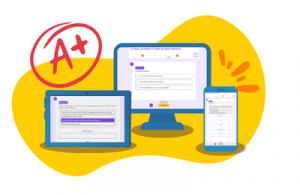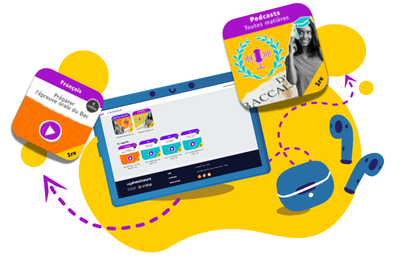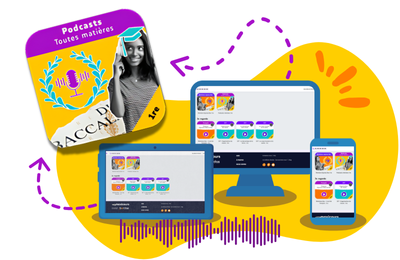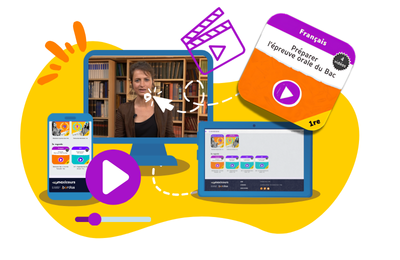The new media
- Fiche de cours
- Quiz et exercices
- Vidéos et podcasts
- Connaitre les différents médias.
- Comprendre la distinction entre les médias traditionnels et les nouveaux médias.
- On peut distinguer les médias traditionnels (journaux, radio, télévision) et les nouveaux médias, diffusés sur Internet.
- Avec internet, chacun peut créer, diffuser et relayer des informations.
- Les bandes dessinées et les graffitis peuvent également être considérés comme des médias car ils véhiculent un point de vue sur l’actualité et le monde.
With the emergence of new technologies, new ways of communicating have appeared. If we used to learn what was happening in the world by reading the papers, listening to the radio or watching the news on television, this is no longer true. Thanks to the Internet, it is now possible to be aware of the situation in the world, even if we do not have a TV set or a radio at home. But what difference does it make ? We will answer this question below and we will also show that other media like street art or comics have their part to play, too.
To start with, we can say traditional media encompasses
media like papers, the television or the radio, whereas
new media is mainly related to the Internet. Physical vs
digital could be a good summary. But are they
opposed ? No, they are complementary in the sense
that both convey information.
In fact it all depends on you. If you are sitting in a
waiting room you can have access to lots of magazines and
even a TV set to entertain you. You can watch/read or
not, it is up to you. But this choice proves that
everything is done to give you access to information,
whatever it is. If you prefer watching/reading on a
screen, why not ? The most important is to learn and
acquire knowledge. Traditionally, the youth will prefer
using a Smartphone and their parents a newspaper, because
they grew up with it.
The main difference today is that everybody can spread news. It is so easy to make up a story and disclose it to the world. In just a few seconds, it can reach the most remote parts of the world. If the piece of news is true, why not encourage people to tell what they think as important, but if it is fake, it must be denounced. Well, some journalists also drop fake news, don’t they ? But this is another problem...
Another difference between both media comes from the fact that thanks to new media, the information can be relayed if you decide to spread it once you have heard it. The electronic devices used help us send the news to those we care for. As I told you, both media are complementary and must not be opposed. They have their advantages and drawbacks, but they serve the information.
They are media, too. Don’t they convey messages and make us think ? Comics were born a little before WWII and played a major part during the war.
Superman was the hero who fought evil like the Americans fought the Nazis. They encouraged the population and entertained it at the same time.
As for street art, we can say that it is often influenced by social or political issues (Northern Ireland, South Africa...). Rather than writing articles in a newspaper, the artists express their hatred, anger or disappointment on the walls of their city, and even though it is a peaceful kind of protest, it is a political act which expresses the opinion of the artist. They want their fellow citizens to react to a situation. Note that street art is often used by big companies for advertising. This is true for painting, too (Guernica...) or sculpture (The Kiss of Death...). Well, art is also a type of media.
Media have existed for a long time under different forms (think of the Indians and the smoke clouds) and they evolve with time of course. We will always have information to spread and any media will be good enough to do it, old or recent.

Des quiz et exercices pour mieux assimiler sa leçon
La plateforme de soutien scolaire en ligne myMaxicours propose des quiz et exercices en accompagnement de chaque fiche de cours. Les exercices permettent de vérifier si la leçon est bien comprise ou s’il reste encore des notions à revoir.

Des exercices variés pour ne pas s’ennuyer
Les exercices se déclinent sous toutes leurs formes sur myMaxicours ! Selon la matière et la classe étudiées, retrouvez des dictées, des mots à relier ou encore des phrases à compléter, mais aussi des textes à trous et bien d’autres formats !
Dans les classes de primaire, l’accent est mis sur des exercices illustrés très ludiques pour motiver les plus jeunes.

Des quiz pour une évaluation en direct
Les quiz et exercices permettent d’avoir un retour immédiat sur la bonne compréhension du cours. Une fois toutes les réponses communiquées, le résultat s’affiche à l’écran et permet à l’élève de se situer immédiatement.
myMaxicours offre des solutions efficaces de révision grâce aux fiches de cours et aux exercices associés. L’élève se rassure pour le prochain examen en testant ses connaissances au préalable.

Des vidéos et des podcasts pour apprendre différemment
Certains élèves ont une mémoire visuelle quand d’autres ont plutôt une mémoire auditive. myMaxicours s’adapte à tous les enfants et adolescents pour leur proposer un apprentissage serein et efficace.
Découvrez de nombreuses vidéos et podcasts en complément des fiches de cours et des exercices pour une année scolaire au top !

Des podcasts pour les révisions
La plateforme de soutien scolaire en ligne myMaxicours propose des podcasts de révision pour toutes les classes à examen : troisième, première et terminale.
Les ados peuvent écouter les différents cours afin de mieux les mémoriser en préparation de leurs examens. Des fiches de cours de différentes matières sont disponibles en podcasts ainsi qu’une préparation au grand oral avec de nombreux conseils pratiques.

Des vidéos de cours pour comprendre en image
Des vidéos de cours illustrent les notions principales à retenir et complètent les fiches de cours. De quoi réviser sa prochaine évaluation ou son prochain examen en toute confiance !









